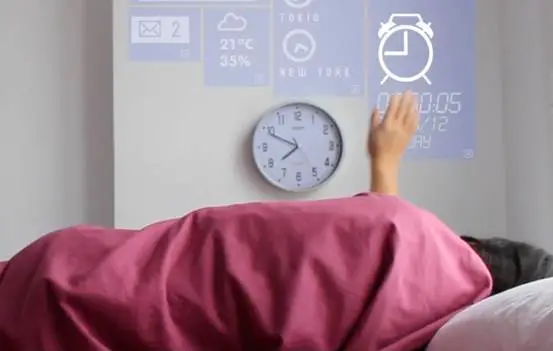Imagine a home of the future and what features it might have. Envision something like the ability to display and browse the world wide web right from a living room wall, or the luxury of hitting the snooze button on an alarm clock projected by your bedside. Even better, imagine being able to sit in your living room and suddenly have the surroundings change to that of a seaside beach escape, or busy street scene. Think of it as something similar to a smart phone, but instead, a “smart home”. Although this type of technology may seem light years away, in reality just such a home has been developed in Spain, in the northern Basque country, in a city called Fuenterrabia.

Interactive Technology
This type of interactive technology works much the same as the type of interactive technology already being used in many video game systems. The developers of this prototype home have used projectors to display interactive applications onto walls and linked them to Kinect motion sensors. These sensors are the same ones used in the X-Box 360 game console, developed by the Microsoft corporation. Residents need simply to wave their hands in order to control various aspects of their environment.
Imagine it being like something a magic fairy might do, wave a hand at the wall to turn off the alarm clock, or to display your daily planner. This technology is also capable of projecting videos and sound effects on each wall that can change the entire environment and feel of the space.
Think Big Factory
This model of a futuristic “smart home” was developed by a Spanish design agency called Think Big Factory. Created by Ion Cuervas-Mons, he launched this project, known as the Openarch project, in November of 2011, building the prototype model in his own apartment. As the leader of the Think Big Factory, he and five architects and engineers work together on various projects. Cuervas-Mons describes the projects as adding a digital layer to a physical space that allows for interaction with digital information. This interactions occurs through people’s gestures and various movements.
At the time, this project is not even half way completed and remains only a living room that is activated by using gestures of the hands. By moving a cursor, you can turn lights on and off, switch music off and on, and open website on the Internet.
The goal of the Think Big Factory is to eventually have the applications that this technology performs now, actually turn into various products for the home. When fully developed, another goal of this technology is that users will be able to work the gadgets in a natural way, using natural movements and gestures. This interactive home system would not be marketed as one whole unit, but rather sold as individual products that can communicate together so that the homeowner can build their own system with the options they like.
Conclusion
The developers of this technology are working with a large retailer, creating the possibility that this type of “smart home” technology might not just be for use in homes. In fact, there is a chance that it may first be used in supermarkets. This would allow for non-commercial spaces to be converted into commercial spaces, creating the ability to buy anywhere, changing the way we shop by being able to purchase from the car, the metro, or your own home. Wouldn’t that be great?
Openarch – A Real Prototype of A Smart Home [Check out the video here]
[Image and Video via Openarch]

I have heard of many Smart Home ideas recently – but still would prefer them to be used at supermarkets and maybe offices first – the technology should be well tested for its reliability and absence of bugs before using them at home I think
I think that’s what exactly the Openarch project is all about, testing the reliability and absence of bugs of this technology on a real prototype of a smart home. How would it turn out? Guess we’ll just have to wait and see.
Proper R & D work needs to be done before launching any technology in the market. Till now Smart Home is just an idea, which has not yet been implemented completely. To turn the idea into reality it will be tested for years before its official launch. Though the idea is quite innovative, it needs a lot of resources for being a reality. Considering the fact that Openarch system requires a lot of hardware & software to interconnect, it should be well tested at bigger Offices, Shopping malls, super markets etc.
The Openarch kind of smart home tech is still developing but app-controlled smart home technology is already a reality.
Peter….I liked this smart home technology. This is really very creative. Thanks for sharing this useful information with us.